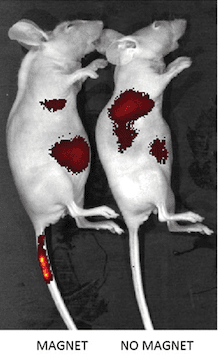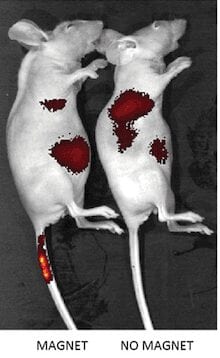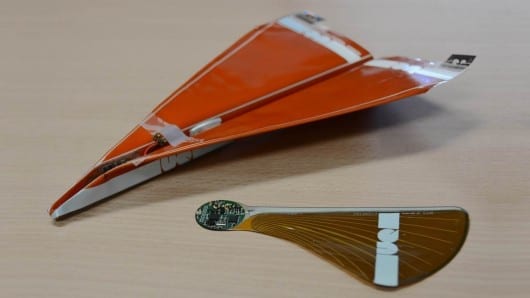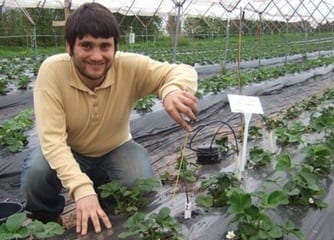
Magnets could be a tool for directing stem cells’ healing powers to treat conditions such as heart disease or vascular disease.
By feeding stem cells tiny particles made of magnetized iron oxide, scientists at Emory and Georgia Tech can then use magnets to attract the cells to a particular location in a mouse’s body after intravenous injection.
The results are published online in the journal Small and will appear in an upcoming issue.
The paper was a result of collaboration between the laboratories of W. Robert Taylor, MD, PhD, and Gang Bao, PhD. Taylor is professor of medicine and biomedical engineering and director of the Division of Cardiology at Emory University School of Medicine. Bao is professor in the Wallace H. Coulter Department of Biomedical Engineering at Georgia Tech and Emory University. Co-first authors of the paper are postdoctoral fellows Natalia Landazuri, PhD, and Sheng Tong, PhD. Landazuri is now at the Karolinska Institute in Sweden.
The type of cells used in the study, mesenchymal stem cells, are not embryonic stem cells. Mesenchymal stem cells can be readily obtained from adult tissues such as bone marrow or fat. They are capable of becoming bone, fat and cartilage cells, but not other types of cell such as muscle or brain. They secrete a variety of nourishing and anti-inflammatory factors, which could make them valuable tools for treating conditions such as cardiovascular disease or autoimmune disorders.
Magnetized iron oxide nanoparticles are already FDA-approved for diagnostic purposes with MRI (magnetic resonance imaging). Other scientists have tried to load stem cells with similar particles, but found that the coating on the particles was toxic or changed the cells’ properties. The nanoparticles used in this study have a polyethylene glycol coating that protects the cell from damage. Another unique feature is that the Emory/Tech team used a magnetic field to push the particles into the cells, rather than chemical agents used previously.
“We were able to load the cells with a lot of these nanoparticles and we showed clearly that the cells were not harmed,” Taylor says. “The coating is unique and thus there was no change in viability and perhaps even more importantly, we didn’t see any change in the characteristics of the stem cells, such as their capacity to differentiate. This was essentially a proof of principle experiment. Ultimately, we would target these to a particular limb, an abnormal blood vessel or even the heart.”
The Latest Bing News on:
Steering stem cells
- Stem Cell Model Illuminates Genetic Drivers of Neuroblastomaon May 14, 2024 at 7:55 pm
These cells carried genetic changes often seen in aggressive neuroblastoma tumours. Using genomics analysis and advanced imaging techniques, the researchers found that the altered cells started ...
- Stem cells provide new insight into genetic pathway of childhood canceron May 14, 2024 at 8:46 am
Scientists have discovered a new insight into the genetic pathway of childhood cancer, offering new hope for tailored treatments.
- CellProthera announces positive Phase I/IIb data for ProtheraCytes® cell therapy in acute myocardial infarctionon May 14, 2024 at 2:54 am
Positive changes in prognostic biomarkers including infarct size, left ventricular dimensions and NT-proBNP level support the anti-remodeling effect of ...
- Exagamglogene Autotemcel for Transfusion-Dependent β-Thalassemiaon April 23, 2024 at 5:00 pm
Exagamglogene autotemcel (exa-cel) is a nonviral cell therapy designed to reactivate ... region of BCL11A in autologous CD34+ hematopoietic stem and progenitor cells (HSPCs).
- Exagamglogene Autotemcel for Severe Sickle Cell Diseaseon April 23, 2024 at 5:00 pm
Exagamglogene autotemcel (exa-cel) is a nonviral cell therapy designed to reactivate ... gene editing of autologous CD34+ hematopoietic stem and progenitor cells (HSPCs) at the erythroid-specific ...
- Stem cell shots and sim rigs: Why David Malukas' future with Arrow McLaren is unclearon April 23, 2024 at 2:31 am
His family believes the ligaments have healed – potentially aided by the stem cell shots they said he received during ... handle a nearly 2,000-pound beast of an Indy car with no power-steering. Asked ...
- Stem cell shots and sim rigs: Why David Malukas' future with Arrow McLaren is unclearon April 23, 2024 at 2:31 am
His family believes the ligaments have healed – potentially aided by the stem cell shots they said he ... pound beast of an Indy car with no power-steering. Asked if he thought his son could ...
- Symptoms of ALS or Lou Gehrig's Diseaseon April 14, 2024 at 5:00 pm
The disease attacks the brain cells that control a lot of your muscle ... feeling in your hand that makes it harder to grip the steering wheel. Or you may start to slur your words before any ...
- What are stem cells and how do they work in therapy?on April 9, 2024 at 11:38 am
Unlike conventional treatments that often inflict collateral damage on healthy tissues, stem cell therapy holds the promise of targeted intervention. By steering the trajectory of stem cells ...
- Unlocking the Healing Potential of Vitamin A in Stem Cell Biology and Wound Repairon March 8, 2024 at 1:12 am
The Role of Retinoic Acid Retinoic acid emerged as a key regulator in steering stem cells towards hair follicle or epidermal lineages. Through a series of experiments, the researchers demonstrated ...
The Latest Google Headlines on:
Steering stem cells
[google_news title=”” keyword=”Steering stem cells” num_posts=”10″ blurb_length=”0″ show_thumb=”left”]
The Latest Bing News on:
Directing stem cells
- Stem cells: A new mechanical transduceron May 10, 2024 at 11:08 am
Scientists reveal how ETV4 controls stem cell differentiation in response to mechanical cues.
- Researchers reveal new cellular mechanical transduceron May 10, 2024 at 7:50 am
A research team has uncovered a novel regulator governing how cells respond to mechanical cues. Their findings appear in Nature Cell Biology.
- ‘Who counts as one of us’: Notre Dame professor wraps up tenure directing ethics centeron May 9, 2024 at 9:04 pm
Who counts as one of us, who gets to do the counting and according to what criteria?” Though it is the broader idea of a future book, it is also a question that Professor O.
- A new mechanical transducer was revealedon May 8, 2024 at 5:00 pm
POSTECH Professor Jiwon Jang and his team reveal how ETV4 controls stem cell differentiation in response to mechanical cues.
- Mice With Hybrid Brains Can Perceive The World Using a Rat's Sense of Smellon May 2, 2024 at 7:52 pm
"Right now, researchers are transplanting stem cells and neurons into people ... Baldwin's team is working on directing these cells to become a specific type, which could improve experimental ...
- BME 495-0-07: Regenerative Engineering Labon August 6, 2023 at 1:51 am
They will also gain hands-on experience in designing and conducting experiments to study the behavior and properties of stem cells, and in developing strategies for directing stem cell differentiation ...
- MERIT Scholar Alumnion April 25, 2022 at 9:39 pm
Dr. Heather Ray received her BS in Biology from Oregon State University in 2006, followed by an MS in Biology from University of Texas at San Antonio in 2009 and her PhD in Cell, Stem Cell and ... Dr.
- Melissa L. Harrison January 6, 2022 at 8:05 am
Research Interests: Somatic Stem Cells and Aging, Genetic Mechanisms of Stem Cell Maintenance ... Here she used the chick embryo as a model to investigate the role of transmembrane receptors in ...
- Hair growing skin produced from human stem cellson December 18, 2021 at 7:53 pm
Now, Karl Koehler at Boston Children’s Hospital, United States, and his colleagues, have managed to generate skin organoids by directing the differentiation of human pluripotent stem cells in a ...
- Research and principal investigatorson March 30, 2019 at 7:26 pm
We have identified and isolated a population of multipotent otic stem cells from the human fetal cochlea and established them as cell lines. We have devised ways of directing differentiation of human ...
The Latest Google Headlines on:
Directing stem cells
[google_news title=”” keyword=”directing stem cells” num_posts=”10″ blurb_length=”0″ show_thumb=”left”]












